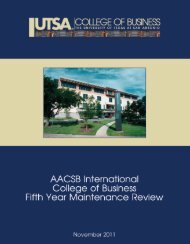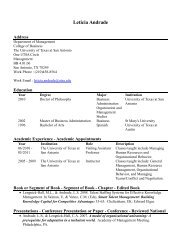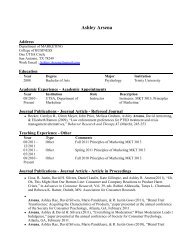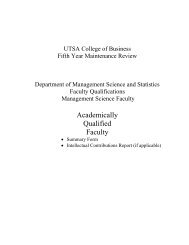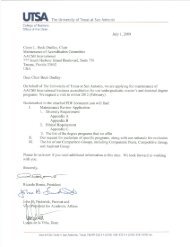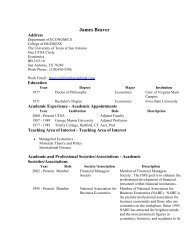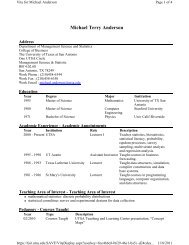Fifth Year Maintenance Report - AACSB - The University of Texas at ...
Fifth Year Maintenance Report - AACSB - The University of Texas at ...
Fifth Year Maintenance Report - AACSB - The University of Texas at ...
- No tags were found...
Create successful ePaper yourself
Turn your PDF publications into a flip-book with our unique Google optimized e-Paper software.
faculty member to maintain a regular exchange concerning any questions th<strong>at</strong> arise. <strong>The</strong> mentors arealso asked to monitor their mentees progress toward tenure and provide regular feedback to facilit<strong>at</strong>ethe achievement <strong>of</strong> tenure.Evalu<strong>at</strong>ion, Reward Systems, TenureAll faculty members are evalu<strong>at</strong>ed each year. <strong>The</strong> annual faculty evalu<strong>at</strong>ion is performed for acalendar year r<strong>at</strong>her than for an academic year and is done in the spring semester. <strong>The</strong> evalu<strong>at</strong>ionincorpor<strong>at</strong>es the three areas <strong>of</strong> faculty responsibility: teaching, research and service.All faculty members have agreed to the distribution <strong>of</strong> workload between the three componentsas outlined in the College <strong>of</strong> Business Workload Policy. <strong>The</strong> evalu<strong>at</strong>ion is performed by the DepartmentChairperson who awards evalu<strong>at</strong>ions for each <strong>of</strong> the components on a 1-4 scale where 1 is the bestscore and 4 is clearly uns<strong>at</strong>isfactory. Each person’s composite score is the weighted average <strong>of</strong> thecomponent scores where the weights are the agreed to percentages allowed under the workload.Unless requested by the faculty member, all workload weights are evalu<strong>at</strong>ed every three years todetermine whether a faculty member should stay on the same track or move to a different track.Merit pay has generally been paid <strong>at</strong> a r<strong>at</strong>e <strong>of</strong> approxim<strong>at</strong>ely 2.25%. Based on eligibility criteriadistributed by the Provost’s <strong>of</strong>fice, percentage merit is awarded using the evalu<strong>at</strong>ion scores used for theannual review. A small amount <strong>of</strong> money is withheld by the dean to provide super merit raises tooutstanding performers.Untenured tenure-track faculty members are informally evalu<strong>at</strong>ed by the Department FacultyReview and Advisory Committee (DFRAC) each year and formally <strong>at</strong> the end <strong>of</strong> their third year.Untenured faculty not making adequ<strong>at</strong>e progress are subject to dismissal or remedi<strong>at</strong>ion. To d<strong>at</strong>e notenure-track faculty have been dismissed as a result <strong>of</strong> a third year review.New faculty hires are generally given two summers <strong>of</strong> summer support upon employment.After those payments have been exhausted, untenured faculty and all tenured faculty members areeligible to apply for competitive Summer Research Grants. <strong>The</strong>se grants in the amount <strong>of</strong> $5,000 arebased on competitive applic<strong>at</strong>ions. In the last three years all accounting faculty who applied havereceived Summer Research Grants.All tenured faculty members are subject to a Period Performance Review (PPE) every six years.This review is similar to a tenure review process except th<strong>at</strong> external reviews are not required. <strong>The</strong>Department Faculty Review and Advisory Committee (DFRAC) evalu<strong>at</strong>es the evidence submitted by thefaculty member in support <strong>of</strong> his or her PPE. <strong>The</strong> DFRAC reports its evalu<strong>at</strong>ion to the Department Chairwho performs an independent assessment and reports to the Dean. <strong>The</strong> Dean receives a report fromthe College Faculty Review and Advisory Committee (CFRAC) and using the Department Chair’s andDFRAC’s reports makes an assessment. Outcomes may range from no action required to cre<strong>at</strong>ion <strong>of</strong> aPerformance Improvement Plan for the faculty member. At the end <strong>of</strong> the Spring 2011 semester <strong>at</strong>enured senior associ<strong>at</strong>e pr<strong>of</strong>essor opted for phased retirement r<strong>at</strong>her than subjecting himself to thePPE process. For untenured tenure-track faculty and for tenured faculty pursuing promotion to FullPr<strong>of</strong>essor, the review process begins with the DFRAC. In the spring semester external reviews <strong>of</strong> thecandid<strong>at</strong>e’s research are solicited from faculty <strong>at</strong> peer or better institutions. In the fall semester aportfolio <strong>of</strong> the candid<strong>at</strong>es teaching, research and service is evalu<strong>at</strong>ed by the DFRAC which makes areport to the Department Chair. <strong>The</strong> chair forwards his or her review along with th<strong>at</strong> <strong>of</strong> the DFRAC tothe CFRAC who then present a review to the Dean. <strong>The</strong> Dean submits his or her evalu<strong>at</strong>ion to theProvost who invites input from a UFRAC. While the process must be legally completed by April, inrecent years it has been the policy <strong>of</strong> the Provost to complete the process by the end <strong>of</strong> the fallsemester.28



